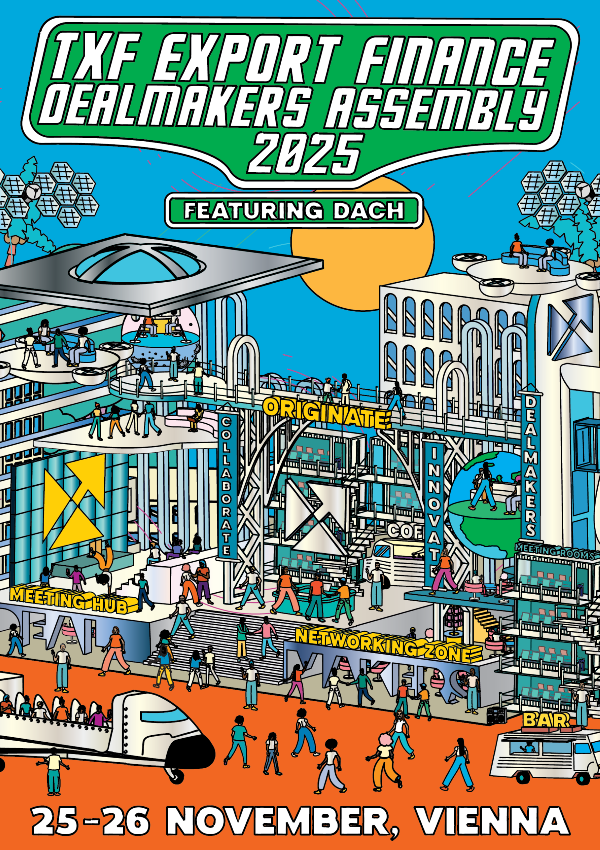EKN: On exporting Sweden’s fossil free energy future
It was unseasonably warm for Stockholm in February at EKN’s annual seminar. TXF was in Sweden to hear about the opportunities to finance the transition to carbon zero. Apparently, no more Nobel prizes need be awarded for some of the technology to make it happen. The financing is a different question.

EKN's director general Anna-Karin Jatko set the tone for the Swedish export credit agency’s seminar in Stockholm on 9 February. She noted Swedish industry’s impressive ability to transform itself. Ibrahim Baylan, Sweden’s Minister for Business, Industry and Innovation made the further point that “winters have been too hot, the warmest seen for more than 140 years.” Their presentations provided a backdrop for financing sustainability.
Two companies, Siemens Industrial Turbomachinery and state-owned mining and mineral group LKAB, are among those doing transformative things in Sweden. Their exports have been covered by EKN for more than 80 years.
The goal set by the Swedish government to be the “first fossil-free welfare society in the world” is an ambitious one, but Baylan is bullish. “It’s a huge challenge, but there are opportunities if it’s done in the right way,” he told the domestic and international banks and exporters, pointing out that the transition won’t be financed and delivered by the government of the country, whose population is only around 10 million, on its own.
Baylan talked about the opportunities for Sweden of steel without coal. Steel manufacturer SSAB had announced in November that it planned to launch the first fossil-free steel products on the market as early as 2026. SSAB, LKAB and Vattenfall, which back the HYBRIT (Hydrogen Breakthrough Ironmaking Technology) fossil-free initiative, have spent or committed to invest SEK1.7 billion ($0.18 billion) on the plan, including Swedish Energy Agency government support of SEK599 million. The aim is to use hydrogen gas instead of coal and coke in the steelmaking process, and the only emission will be water. Baylan expects a fossil-free steel industry, as just one sector, could have multiplier effects to the extent of 50 times Sweden’s total CO2 emissions. “It’s not just an issue of being nice to nature, but it is what’s best for Sweden as an economic strategy.”
After all, if it is effective, he asks, “who is going to want to finance non-fossil free steel after 2030?”
Siemens: The tech is there already
Hans Holmström, CEO of Siemens Industrial Turbomachinery, discussed the need for transformation of the energy sector. His €1 billion turnover company employs 3,300 people in Sweden and exports 95% of its output. His key point was that the technology is already there. Gas turbines, the company’s main focus, don’t run only on fossil fuels, rather there is the opportunity for them to be run on hydrogen or biogas or other non-fossil fuels.
The combination of sustainability, availability and affordability of power globally remains important and Holmström argues there are many steps that can already be taken, including efficiency, making hydrogen out of excess electricity (for instance when wind turbines are turning but their output can’t necessarily be stored), that can help with the transition to decarbonisation. He used the example of a project for a 15-year old Goteberg Energi gas-fired plant which will convert it to one able to use hydrogen or biogas within the year. “Our ambition is not only to make Sweden fossil free but there are thousands of plants like this one around the world. If we make them use fuel that is less carbonised step by step, we can make a huge impact.” Siemens is running test pilots where different fuel sources coexist.
Gas-fired as the ‘gateway fuel’
But the first step is moving from coal to gas-fired plants. “Gas-fired is a step in the right direction,” Holmström says. It not only dramatically cuts carbon emissions but also opens up the opportunity to move further onward to other sources of power at a later stage and avoids what Holmström calls the lock-in effect of staying with coal. This is an important intermediate step in the large number of old coal-fired plants in eastern Europe, for instance.
“If we are to make an impact on CO2 reduction,” he argues, “there needs to be transportable fuels.” Generating hydrogen from excess electricity is going to be a key element in the transformation as battery storage solutions alone are not necessarily going to cut it, Holmström argues. The industry jargon is ‘Power to X’ (ways to change electrical energy into liquid or gaseous chemical energy sources through electrolysis and further synthesis processes), which can be green fuels created out of renewables. Siemens has already sold turbines to Brazil running on 60% hydrogen. “We believe there can be 100% hydrogen combustion within a few years’ time. Technology is not going to be a problem, but the problem will be finance.”
Green alternatives will likely need initial subsidies and/or the taxation of dirty production, as did wind power in the first instance, the theory being that once established, the market will sustain itself.
Holmström also addressed the issue that the oil and gas industry will not “lie down and die” simply because people say fossil fuels are bad, and will need support in its ambitions to decarbonise. Methods such as carbon capture at source could be encouraged.
Aptly, given the location of the discussion, Holmström said there’s no need for any more Nobel-prize winning breakthroughs. “The technology already exists but we need a market for fossil free fuels and capital for the transition from dirty to clean power. The opportunity is there.”
Carbon-free mining
Markus Petäjäniemi, senior vice president, market & technology at LKAB which mines and processes iron ore from Norrbotten was keen to emphasise that people who don’t think we will need mining in the future are wrong, “but we do need sustainable mining.” He discussed the application of the HYBRIT fossil-free steel project and the carbon-free mine of the future, work on sustainable underground mining with ABB, Epiroc, Combitech and Volvo Group, virtual test mines, and the future of extracting phosphorus and rare earth metals from years of mining tail waste. Last November, LKAB issued a SEK2 billion dual-tranche ‘green bond’ to finance some of the initiatives.
Marie Aglert, director, large corporates at EKN, pointed out that when she started at the ECA, the focus had just shifted from political risk to political and commercial risk. Now there’s also sustainability risk. “It may have started as reputational risk alone, but now it’s about companies’ repayment capacity. EKN promotes exports and also contributes to the Paris Agreement. We would like all ECAs work in the same way, to have the same responsibilities, to work towards the same goals and be on a level playing field.”
The opportunities are there in the transition to carbon zero. It looks as if ‘Team Sweden’ (as the EKN and SEK respectively guarantee and funding partnership call themselves), which is actively targeting international EPC contractors and banks to source through Sweden, is keen to take them.
Watch out for my interview with EKN's director general Anna-Karin Jatko, to be published soon as part of TXF’s Keynote series talking to leading players in export and trade finance, which will go into more depth about EKN’s strategy.
Now time to get up to speed on the markets.
Here's our exclusive TXF in depth articles
Keynote: SERV’s CEO thinking outside the box
What does being a modern ECA mean? Peter Gisler, CEO of SERV has strong views on the Swiss ECA’s ability to be proactive, flexible and to think outside the proverbial box of options available. Nonetheless, it isn’t always an easy path. Gisler shares his thoughts with TXF.
Expert briefing: Stormy waters ahead for global trade and shipping
The maritime industry’s growing regulatory complexities and lengthy paper-based loan application procedures are convoluting access to trade finance for corporates in the sector. But can digitisation raise the levels of compliance and put an end to sanction headaches and shipment delays?
Amur GPP: Better than the black stuff
The heavily ECA-backed financing for Gazprom's Amur gas processing project has set new tenor and volume benchmarks for both the sponsor and Russian oil and gas – even allowing for some hefty politically driven Chinese and Russian bank participation. But it is still a fossil fuels deal, primarily aimed at Chinese offtake. So should EU domiciled ECAs be backing it?
Exclusive TXF Tracker and Originals content
More details on Tete coal-fired plant and mine deal
Sponsors of the 300MW Tete coal-fired power plant and coal mine project in Mozambique – CMEC/GE (60%) and Ncondezi Energy (40%) – are expected to reach financial close on the funds backing the scheme in H2 2020.
Turkmenistan eyes Komatsu as EPC for lake project
Turkmenistan’s Ministry of Finance (MoF) is yet to sign commercial contracts with prospective EPC contractors for development of the second phase of the Altyn Asyr lake, a man-made lake in the middle of the Karakum desert.
GIEK covers two Norwegian wind farm PPAs
GIEK has provided coverage for two PPAs for the Tysvaer (47MW) and Buheii (69MW) wind projects in Norway.
Cocobod to close $600m term loan this week
Ghana Cocoa Board’s $600 million receivables-backed term loan is due to close this week. Signed in November 2019 at the African Development Forum, the facility comprises a $250 million seven-year development tranche and a $350 million five-year commercial tranche, led by AfDB and Credit Suisse respectively.
Arun Sharma leaves IFC
Arum Sharma, previously chief investment officer at the IFC, has left after nearly 30 years of service and started his own advisory company, Grovepick Associates.
Hornsdale wind project refinanced
Neoen and John Laing have refinanced the project debt on their 309MW Hornsdale wind farm in South Australia.
Al Kharsaah solar IPP to close in Q2
A Marubeni-led consortium is expected to close project financing in May to back phase one of the 800MW Al Kharsaah solar IPP in Qatar. Bank mandates are expected imminently.
CIP signs on Taiwan offshore wind debt
Copenhagen Infrastructure Partners (CIP) has signed NT$75 billion ($2.5 billion) of loans to finance development of 600MWs of offshore wind farms in Taiwan – the 100MW Changfang 1, 452MW Changfang 2 and the 48MW Xidao projects.
Tatweer 2 schools PPP tender started
Tatweer, on behalf of the Saudi Ministry of Education, has started the tender for its second batch of school PPP projects.
West Dammam STP signed
Sponsors of the West Dammam 350,000 m3/day sewage treatment project – Metito, Orascom and Mowah – have signed documentation for the $230 million scheme.
Orsted taps ECAs for Taiwanese offshore wind projects
Orsted is expected to close a NT$50-60 billion ($1.66-1.99 billion) ECA-backed loan in June this year to finance the 900MW Greater Changhua 1 and 2a offshore wind farms in Taiwan.





